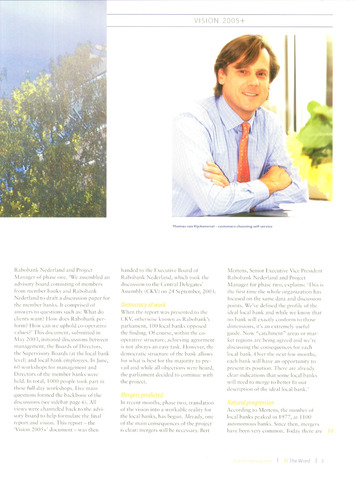*»Vr
t-""* v, il.'fe'
VISION 2005
J A*
Thomas van Rijckevorsel - customers choosing self-service
Rabobank Nederland and Project
Manager of phase one. 'We assembled an
advisory board consisting of members
from member banks and Rabobank
Nederland to draft a discussion paper for
the member banks. It comprised of
answers to questions such as: What do
clients want? How does Rabobank per-
form? How can we uphold co-operative
values?' This document, submitted in
May 2003, initiated discussions between
management, the Boards of Directors,
the Supervisory Boards (at the local bank
level) and local bank employees. In June,
60 workshops for management and
Directors of the member banks were
held. In total, 1000 people took part in
these full-day workshops. Five main
questions formed the backbone of the
discussions (see sidebar page 6). All
views were channeled hack to the advi
sory board to help formulate the final
report and vision. This report - the
'Vision 2005+' document - was then
handed to the Executive Board of
Rabobank Nederland, which took the
discussion to the Central Delegates'
Assembly (CKV) on 24 September, 200.3.
When the report was presented to the
CKV, otherwise known as Rabobank's
parliament, 100 local hanks opposed
the finding. Of course, within the co-
operative structure, achieving agreement
is not always an easy task. However, the
democratie structure of the bank allows
for what is best for the majority to pre-
vail and while all objections were heard,
the parliament decided to continue with
the project.
In recent months, phase two, translation
of the vision into a workable reality for
the local banks, has begun. Already, one
of the main consequences of the project
is clear: mergers will be necessary. Bert
Mertens, Senior Executive Vice President
Rabobank Nederland and Project
Manager for phase two, explains: 'This is
the first time the whole organization has
focused on the santé data and discussion
points. We've defined the profile of the
ideal local bank and while we know that
no bank will exactly conform to those
dimensions, it's an extremely useful
guide. Now "catchment" areas or mar-
ket regions are being agreed and we're
discussing the consequences for each
local bank. Over the next few months,
each bank will have an opportunity to
present its position. There are already
clear indications that some local banks
will need to merge to better fit our
description of the ideal local bank.'
According to Mertens, the number of
local banks peaked in 1977, at 1100
autonomous banks. Since then, mergers
have been very contmon. Today there are
The Word I 5

